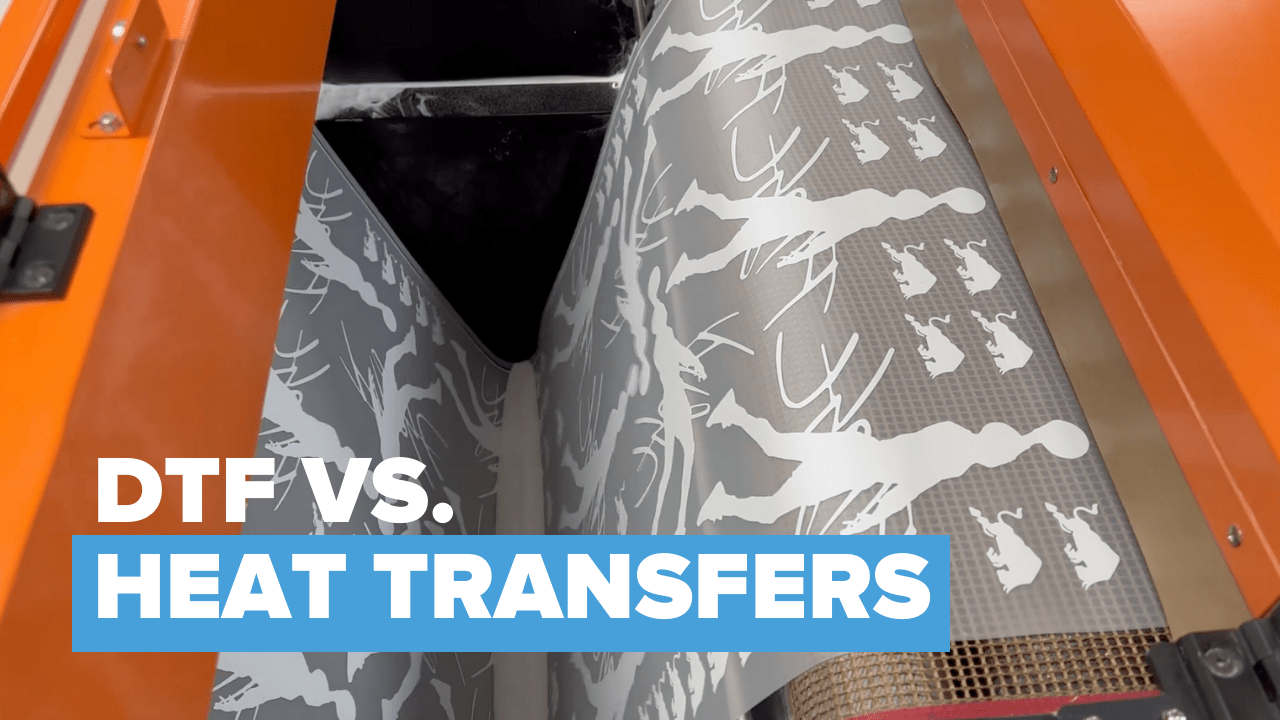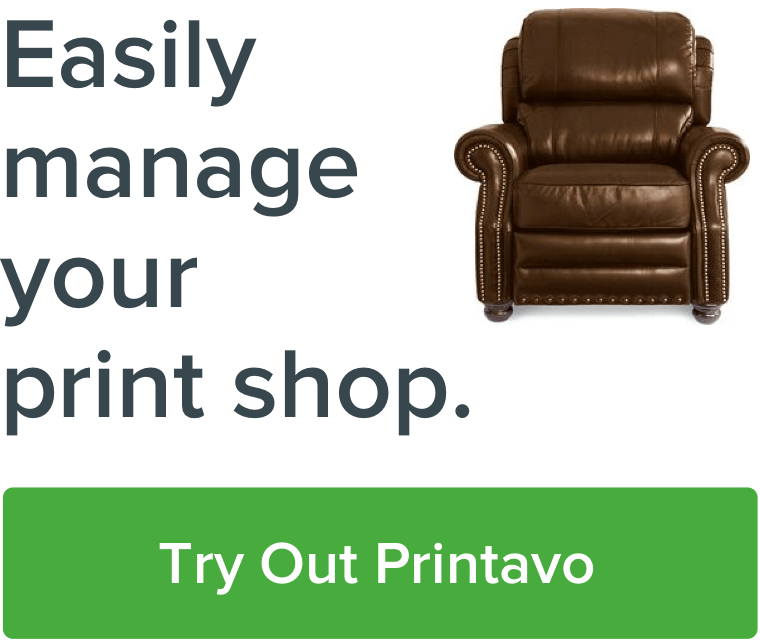DTF printing was everywhere at 2022’s Impressions Expo show at Long Beach. You might assume we’re on the cusp of a revolution in the custom printing industry.
Heat transfers, by comparison, are a time-tested technology. Heat transfer vinyl (HTV) has been sold for decades by print shops doing custom apparel. There’s a robust market for heat presses and HTV that’s grown significantly.
But the outlook for DTF printing vs. heat transfers breaks down into three distinct camps:
- The Excited Optimist: DTF is really exciting technology that enables on-demand, one-off custom garments and is finally available at a reasonable price. So it makes sense that everyone would be interested and the manufacturers would want to sell it. HTV will be gone within a few years.
- The Sober Evaluator: DTF is an emergent technology, probably great in the right hands, but still not quite ready for prime-time in a busy shop. It might be perfect for certain jobs and applications, but it’s not going to conquer the industry. HTV is here to stay.
- The Bitter Cynic: DTF is a total gimmick. It’s not anywhere near the quality HTV can offer.
That is a very big range of opinions!
So it brings up some practical questions:
- What is DTF printing? How does it work?
- Which is better – DTF or HTV?
- What’s DTF printing for, anyway?
- Who leads the market, and how much does it cost?
I enlisted help from Jim and Chris with Cobraflex – a leader in the DTF printer space. They were willing to chat with me and help set the record straight.
What is DTF printing?
Direct-to-film (DTF) printing is a multi-step garment decoration process where an Inkjet printer applies ink to a film made out of PET (polyethylene terephthalate).
Then, an adhesive is then applied to the print, and the print is cured with high temperature. This curing process allows the PET film to be stored for long periods of time without significant image quality loss.
When a print shop wants to use a DTF print, they simply prepare the fabric as needed (for instance, cotton garments are typically pre-heated with a heat press while polyester garments do not require any special treatment), then apply the printed DTF image directly to a garment with a heat press.
The image is fastened to the garment with the adhesives applied in the second step through the heat and pressure applied by the heat press.
Takeaway: DTF printing is a process. An Inkjet printer applies ink to PET film, which is then cured. A print shop can then apply the printed image directly to a garment with a heat press.
How DTF printing works
DTF printing works through the use of high-quality adhesives to fasten the print to a garment.
Most DTF printers use a powder-based adhesive. This adhesive actually lets print shops determine the hand feel of their DTF prints. For instance, a shop can choose to use glossy, matte, or even soft-hand adhesives for different applications and softer shirts.
DTF prints can be applied to almost anything that can withstand the heat and pressure required to apply the print.
Because DTF prints aren’t limited to one type of fabric, and because the inks don’t have to interact with the substrate, DTF printing is incredibly flexible. Some common DTF printing applications include:
- T-shirts, hoodies, and other typical garments
- Jeans, nylon, and other hard-to-print surfaces
- Athletic supplies
- Leather items
- Hats
- Neck tags
“It’s not a printer, it’s a process. Time, temperature, and humidity matter! We’ve alleviated a lot of the trouble because of the adhesives. Inkjet printers love humidity, adhesive powder hates it, so it’s yin and yang in the same room. When you buy a printer, you’re really buying a process. If you follow the process, you’ll have success.” – The Cobraflex team
What are heat transfers (HTV)?
Heat transfers (usually called HTV printing or heat transfer vinyl) are a time-tested method for applying simple decorations to garments. Millions of athletic uniforms have been customized with vinyl lettering and numbering. Some argue that custom HTV printing is the real origin of print shops!
However, “heat transfers” are really a broad umbrella of techniques and methods for applying graphics onto garments.
The way we see it, there are two MAJOR categories of HTV printing:
- Print your own heat transfers. Some shops actually make their own heat transfer vinyl in-house. This can be achieved with a Cricut machine, through transfer paper, and through several other methods (such as screen printing!).
- Have someone else print your heat transfers. In many shops, the actual HTV printing is outsourced to another business. The shop will order as many HTV prints as it needs, then have them shipped to their business where they’ll apply the designs.
There are a lot of subcategories for vinyl printing. Vinyl is a wildly effective and multi-purpose tool for garment decoration.
Which is better: heat transfer (HTV) or DTF?
This is a very subjective issue, and it depends on your individual situation – and what you’re trying to accomplish.
But we can still tell you what DTF is good for, what HTV is good for, and who would be a good fit for each type of decoration.
If you’re new to printing, heat transfers are a better place to start than DTF printing. Our reasoning: DTF printing has a higher initial cost, is more technically advanced, and it requires more consumables to get started.
If you already own a print shop, DTF printing is probably superior (and more versatile) to heat transfers. DTF printing can be used for a wide range of products, is similar to the process for creating films for screen printing, and delivers a production-quality product under ideal circumstances.
DTF printing is great for:
- Full color images
- Items that are hard to print on
- Larger prints
- Short runs and one-offs
- Quick turnaround
But HTV printing has major upsides, as well:
- Low cost, low overhead
- Simple to use
- Many options
- Time-tested
So before you decide whether DTF printing or HTV printing is right for your business, think about what you need to get out of your printing technique. If you need speed, flexibility, lots of colors, and decorate lots of different items, maybe DTF is a better fit. If you’re sticking to athletic wear and just want to make simple projects, HTV could be a fantastic fit. One isn’t clearly better than the other because they both excel at different tasks.
Downsides to DTF printing?
Misinformation: I can’t exaggerate here: there is a lot of misinformation about DTF printing. For the mass consumer, this is still a very new technology in the US custom printing market. Searching Google for “DTF printing” will yield some very weird results from websites that seem to have been translated directly from another language.
Low barrier to entry: I’ve talked extensively about how the low barrier to entry for custom printing means that it’s a super competitive and challenging market. This puts a ton of pressure on every player in the space. Part of the reason that DTF printing exploded “overnight” is that there’s a big mass market for entrepreneurs in the custom merch space.
Cart before the horse: DTF printing is rising in popularity because it’s pretty easy to convert a traditional inkjet printer into a semi-functional DTF setup. Have you ever heard the phrase “sell shovels in a gold rush”? It means that when there’s a gold rush, you shouldn’t go dig for gold. You should sell shovels to all of the people that are going to dig for gold. I have a sneaking suspicion that there is a fairly large amount of this happening in DTF markets. It’s speculation! DTF is obviously going to be a big market, but who and how are still totally up for grabs.
A lot of consumables required: DTF requires a constant supply of ink, PET film, and vinyl adhesive powder. The cons here are obvious. You’ll need to control your supply from supply shocks (read: bulk purchases) and can’t keep working if you run out of consumables. Not all DTF consumables are interchangeable.
Your heat press matters!
The biggest lesson is that your heat press matters. Cobraflex urged anyone trying DTF to take a careful look at their heat press. “An old junker from the 1980s won’t cut it. You need even temperatures, pressure, and a good handle on how to use it.”
But once you have it dialed in, they say it’s smooth sailing, and virtually anyone can be trained to heat press. Compared that to the skilled operators that screen print shops seek.


0 Comments